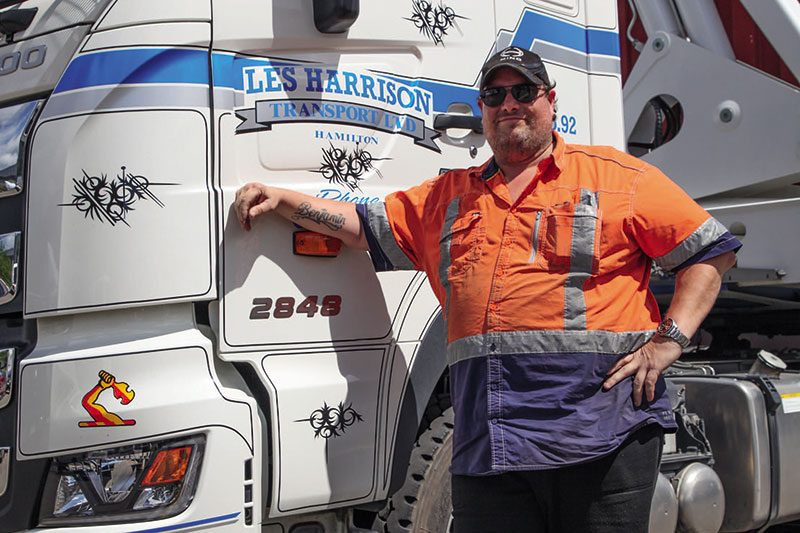Covering the bases
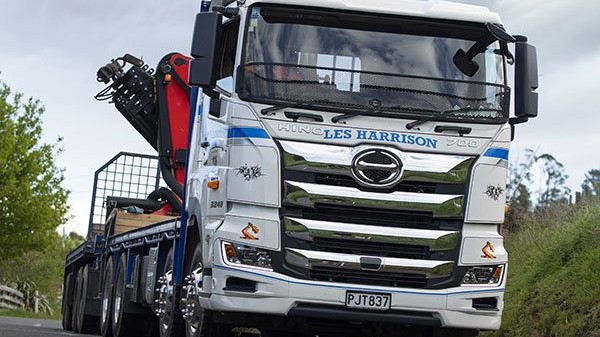
Hino’s new 700 enters the market in the wake of new models and updates from rival Japanese manufacturers, ushering in new efficiency, technology and safety features. The 700 also follows nearly two decades of solid dependability and industry performance by its predecessor. It has a lot to contend with, and live up to. Let’s find out how it fares.
It’s been a long time coming. Images of the ‘new’ Hino 700 have been circulating for at least five years. But, details of this new model, which has slowly been introduced to selected markets, including Hong Kong, Singapore, Taiwan, Australia and New Zealand, have been scant. We waited patiently, with no official word on when – or even if – it would arrive.
Then, in 2021, murmurs started reverberating… and by September of that year, as if out of nowhere, Sime Darby Motors NZ announced it had officially launched the new 700 into the New Zealand market.
By the time the new model was announced, the previous-generation 700 had enjoyed an almost two- decade run; a stalwart in the brand’s heavyweight portfolio in several global markets and on local soil. In fact, the Foodstuffs 450hp FS 700 6×4 truck tractor that graced the cover of our August 2004 issue was one of the first to go to work worldwide. Long in the tooth, it may have been, but there’s no denying the 700 had staying power, continually holding its own against the Gigas, HDs and Quons of the world, as well as various lighter-spec Euro models.
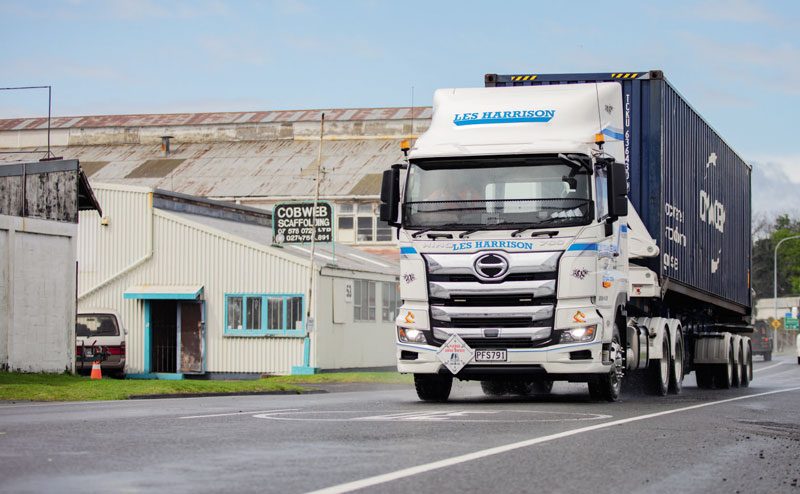
Lockdowns, chip shortages and supply-chain lethargy aside, the new model has begun to appear on local roads as orders have been fulfilled. We thought we’d watch from the sidelines before finding the ideal model in a typical operation to have our first taste. What transpired was one of those unexpectedly fortuitous opportunities.
While not quite the staggering 37 years it took before Southern Transport appeared on the cover of New Zealand Trucking magazine, in its 20-year history, North Island transport provider Les Harrison Transport has been featured in the magazine but never on the cover. Les is undoubtedly one of the industry’s good fellas, and his partners in the business, Craig Foster and Chris Flavell, too are real salt-of-the-earth types who go way back with Les. Undoubtedly, that was already a story waiting to be told (see Friends and family, page 36).
As for the 700, there could hardly be a fleet more dedicated to the model than that of Les Harrison Transport. While there’s been the odd truck from other suppliers to meet contracts or fulfil a specific need, Hino has been the company’s bread and butter since 2008, when the company bought its first truck from Sime Darby Motors NZ. The brand makes up 78% of the 100-strong fleet, making it truly a part of the Les Harrison family.
“They’re a good day truck,” says Les. “They are comfortable, and the chassis are heavier and stronger – you can do a lot more with it, extend it a little more, make the cab ride better. You don’t have to do much to the subframe for a hiab, which saves on cost.”
“Partnership is a pretty fluffy word,” adds Craig. “But Sime Darby is generally pretty good; our relationship is pretty good.”
For New Zealand Trucking, the variety within the LHT operation meant we’d also be fortunate enough to sample two different models in two different applications. First up, we’d meet Kareaua Karokoua and his FY 3248 8×4 rigid crane truck and four-axle trailer at the company’s head office at Empire Road, Hamilton. Two days later, we’d find ourselves in the company’s Mt Maunganui yard to meet Glen Mosely and his FS 2848 6×4 with tri-axle Patchell swinglift. The Mount branch is home to 15 crane units, three side lifters and two flatdecks, all of which can be found from Coromandel to Wellington.
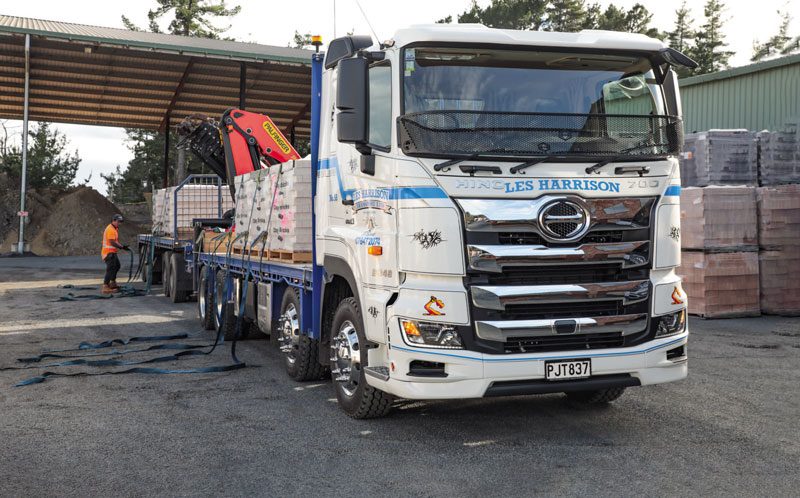
Smiles on the dial
A broad beaming smile you can spot a mile off, a friendly laugh and an easy-going aura as he goes about his business – that’s Kareaua Karokoua, known around the Les Harrison yard as Kare. We clock him before we’ve even walked through the gates, and after a brief but engaging introduction, we’re all lined up and heading out the gate into the Hamilton traffic.
Our run for the day is typical for Kare. From the yard, we’re heading a few minutes north to Clay Bricks in Huntly to collect the day’s load; the seven pallets on the truck are bound for a new build in Piopio, and the five on the trailer to one a little closer to home in Pirongia. Shifting bricks is the main role of LHT58, though it is called into action for other jobs when needed.
Having just joined the fleet and with a mere 8200km on the clock when we meet up with it, Kare’s 700 is typical LHT fare for four-axle crane trucks. The 7m deck is from Foremost Engineering, a small company that employs old- school engineering to produce seriously good products, which has found a home in the LHT fleet over the past six or seven years.
The crane on the back is another Sime Darby Motors product, a 5.6-tonne, 17m Palfinger PK 22002-EH unit.
“We have the experience and have that physical input to how the truck behaves on the road with another five tonne of weight over the back axle. So, we build them to our specs as a person who’s at the sharp end of the dollar. A lot of thought has gone into them,” comments Les.
Hooked to the Ringfeeder is an MTE 4A flat-deck trailer, which has been around the block a few times. But there’s a very good reason for that. “I always use this trailer because it’s on air and that’s good for the bricks. They don’t bounce – we don’t want them to crack. It’s good for the job,” Kare explains. Enough said. Similarly, the truck’s rear end rides on Hendrickson air. “It’s bulletproof,” Les says.
At 1.2-tonnes per pallet, it’s fair to say LHT58 won’t be challenged by its 14.4-tonne payload today. Nonetheless, we’re here to see the truck in typical action, so that’s fine with us. Lined up at Clay Bricks, Kare’s off to an easy start as owner Eric Finlay zips pallets off the stockpile with the forklift and loads up the truck in no time.
Hey, good looking
Watching on from the sidelines gives us the perfect opportunity to have a good look at the 700 and assess the new lines in the soft early morning light. And wow, what a great job the designers have done. The overall impression is a much bolder presence. The windscreen is taller but offset by the larger Hino logo set in the bold four-plane chrome grille. Gone are the large indicator housings that were characteristic of the old model, the indicators now integrated into the headlight housings that remain low and right at the edges of the deeper bumper. These units now also incorporate LED daytime running lights, LED low beams and halogen high beams. Hino has also extended the doors to cover the second step, which goes a long way to harmonising the front-three- quarter appearance.
Looking at an old and new model side-by-side, the same basic character lines that define the 700 are retained, but the overall appearance is sharper, more chiselled. It’s evolution and revolution in one, and definitely one of the most handsome cabovers on the market today.
While we’re talking design, it’s fair to say Hino has injected more flair into the interior redesign than its Japanese rivals have into their current offerings. Okay, the predominant brown plastic covering the lower door panels, centre trays and passenger-side dash might not be to everyone’s taste. But, combined with the beige headlining, overheads and back panelling, it is a welcome change from the traditional (and often drab) greys and silvers. A peppering of circular air vents also adds character.
Facing the driver is a comfortable, well-sized four- spoke wheel with phone and multi-info display controls to the left, and cruise and skip forward/back buttons on the right. Two large, clear gauges for speed and revs (including two smaller needles for front and rear air pressure) flank the multi-info display. This offers digital temp, fuel and DEF levels, and various menus for comprehensive trip, safety, cruise and eco information.
The left-hand wands between the wheel and instruments control wipers and auxiliary braking above, gear shifts below, with the right lights and indicators. The main gear selector for R-N-D is a nifty rotary knob mounted on the dashboard alongside a double bank of auxiliary switches and the park brake lever. Above, surrounded by faux carbon fibre trim, are the HVAC controls, RT slot and 6.5in touchscreen infotainment system.
Atop the dash is a handy storage tray, with another at the passenger side of the dash. More trays and cup holders are in the lower console and between the seats. This central tray/cubby is not as substantial as those in the UD or Fuso, or even the new Isuzu. But whether that’s good or bad in the context of traditionally chunky Japanese cabs will likely come down to personal taste. And the trailer brake mounted between it and the driver’s seat does look a little ‘tacked on’… surely there could’ve been a way of integrating that to match the great execution of the rest of the interior? There’s a pair of cubbies overhead (with interior light controls and more auxiliary slots on either side of the driver’s) and a thin, liftable bunk behind the seats.
Easy going, quiet running
Before we know it, Kare has the load stropped down, and we’re headed south on the expressway for Pirongia. This will be our first introduction to Kare’s unhurried temperament. The build is located off a twisty rural road up a steep dirt driveway. Like any good operator, he gets out the truck to suss out the site beforehand – and promptly concludes there’s no way he will get the truck and trailer into place. As it’s the trailer load destined for the Pirongia build, Kare hatches a plan to park the trailer about 10 minutes further up the road, head down SH3 to offload at Piopio, and then trans-ship the trailer load onto the truck for the Pirongia build later.
“I always have a plan,” he explains. “From experience, I’ve learnt to look at a map of the local area the night before I go out and plan what I can do with the trailer. Sometimes you might have enough space on a country road just to park it up, but jobs on main roads can be problematic.
“It’s an easy job, but it takes patience,” he laughs.
With an application that can’t exactly be described as taxing, Kare’s 700 epitomises ‘under-stressed’, and so the 353kW (480hp), 2157Nm (1591lb/ft) E13C-BK offers up more than enough grunt. The E13C is the same, dependable lump of iron (and quite a physically large one at that) that has performed diligently in the 700, but in this guise, includes selective catalytic reduction (requiring DEF) to now meet the Euro-6 emission standard. Though it’s still new, LHT58 is currently registering around 2.5km/l.
No manual transmissions are available with the Euro-6 powertrains – just a six-speed Allison automatic or 16-speed ZF AMT. The 16-speed TraXon transmission would prove smooth, quick and intuitive in both trucks, with both drivers commenting on how well it’s been tuned to make full use of what the E13C has to offer.
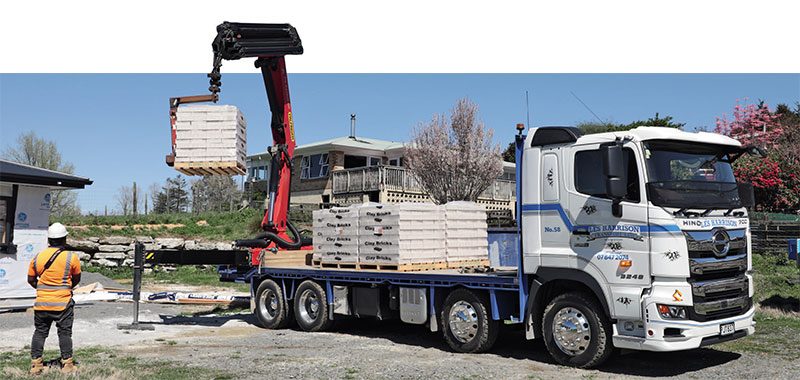
Despite its light payload, one of the first things noticeable as we hit the road is how nicely the FY 3248 cruises. Sure, there’s the odd kick from the front load-share suspension, but comfort is good, and by all accounts, Kare is impressed by the truck’s stability. It cruises with a ‘linehaul’ attitude.
“I really like this truck. It’s comfortable inside, it cruises nicely, and it’s quiet,” Kare says.
Indeed, the low noise levels in the cab are the next most noticeable attribute once up to cruising speed. The 8×4 recorded an impressive average in the 75dB range, and we were even more impressed when the 6×4 bettered that at 73dB.
“If I get too close without indicating for an overtake, for example, it’ll sound an alert – not a very loud sound, but at least the dash also flashes red. If I have the radio volume up, I can only see it light up,” Glen comments.
Applying the engine brake or three-stage intarder will automatically shut off the system. “I haven’t got close enough to a vehicle in front to find out if it’ll come to a complete stop. I’m hoping it will, but I don’t really want to test that one,” Glen says with a laugh. “But if you come up quite fast, it’ll put all your retarders on and slow it right down.”
Like many drivers of trucks fitted with similar systems, Glen comments that while the LDWS works fine on an expressway, he’ll usually shut it off on any other road. Once we find those other roads, turning off towards Kawerau, it’s apparent the 6×4 rides along as well as the 8×4. Like Kare, Glen notes the comfort and quietness in the cab and triumphantly declares that one of the most consistent criticisms of the old model by some drivers has been righted: “In the old one, you couldn’t get the seat back far enough. It now has a lot more room for the driver.”
The two men also agree the new 700 has some exceptional mirror units. The main and wide-angle units are well-positioned with solid arms and housings and offer a large, clear view rearward. They’re heated, too.
Lifting and pulling
The loading dock at Essity Kawerau requires Glen to put the container on the adjacent loading platform, raised approximately a metre. The containers also highlight one of the more annoying aspects of the new 700 for Glen. He explains: “The sensor for lining up the containers has a green light and a red light. When you’re in reverse at night, those lights come on, and normally, I’d turn the lights off and on again to cancel them. However, ‘off’ for the headlights is ‘auto’, meaning they’ll always come on at night, so I have to turn the truck off and on again to cancel the sensor lights.”
Loaded up, we turn back for the port at Sulphur Point. The payload is naturally noticeable, but at no point in the journey does the 700 show strain. “It goes all right,” says Glen. “For what we use it for, 480hp is plenty. The power seems more useable; they’ve done some tuning.”
At first glance, the move to Euro-6 has little changed the characteristics of the E13C on the previous Euro-5 VG variant. However, while peak power and torque figures have remained unchanged, their delivery has indeed been refined. Whereas before the full 353kW peaked at 1800rpm before dropping off a cliff, and max torque peaked at 1100rpm before declining through the rest of the range, power now peaks at 1600rpm, plateaus to 1800 and drops off only marginally after that. Torque peaks 100rpm earlier and plateaus to 1500rpm with a more gradual decline through the rest of the useable range. At 90kph, the E13C sat just on 1500rpm.
More useable it should definitely be… Although lacking the outright grunt of the Shogun 510’s OM471, it’s more than a match for the Quon’s slightly torquier GH11TD and the Giga’s peaky 6WG1 warhorse.
Under load, the E13C gathers speed with more of a guttural, thumping beat punctuated by crisp, well-timed shifts. “I’ll generally leave it in auto. This gearbox is a lot better than others I’ve experienced; it changes a lot closer to what I would do,” says Glen. He adds it’ll start off as high as seventh and will allow a skip shift of up to three ratios up and down the box when driven in manual. Both drive and reverse have a ‘slow’ mode for precise manoeuvring. LHT92 is currently averaging 2.1kpl.
Conclusion
Two decades of familiarity and dependability have ensured the previous-generation Hino 700 became a mainstay in fleets worldwide. In Aotearoa, the 700 has also filled almost every need in the heavy-transport sector. Now, the baton has been handed to a new generation.
The improved ride comfort, refinement on the road, re-tuned drivetrain characteristics, quality of materials and – importantly – interior space for the driver, move this model leagues ahead of its predecessor. And there’s little doubt that the improvements have lifted the 700 back to a prominent position among Japanese trucks. It is smarter both in looks and technology, which will no doubt please drivers and fleet/operations managers, especially in terms of the active safety fitted to the FS 2848.
In an operation such as Les Harrison Transport’s, there’s no doubt the 700 will continue to form an integral part of the ‘family’.
As for our time with the Les Harrison team, and as you’ll read in Friends and family over the page, it was a glimpse into what a powerful force childhood dreams and aspirations are, especially when channelled in the right direction. The very genesis of the Les Harrison Transport Group is owed to one young lad’s hard work and determination. He turned his boyhood passion into a one-truck owner-driver operation, then over time, organically grew that business through whanau, friendships and partnerships into what has become a significant logistics provider.

Quick reads from Test
Read more
The right man for the job
0 Comments29 Minutes
Legendary ambition
0 Comments36 Minutes
Hard Fought!
0 Comments40 Minutes
Postal Trifecta
0 Comments29 Minutes




















